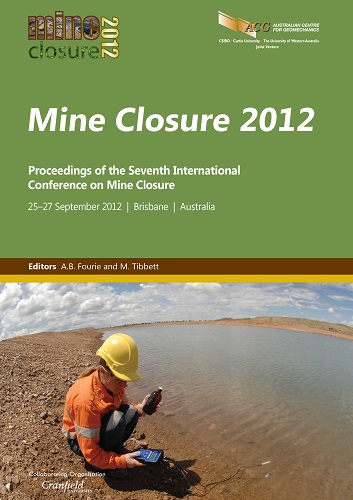Using risk assessment to guide progressive closure planning for the Ok Tedi Mine

|
Authors: Mackenzie, S; Topurua, A; Werror, M |
DOI https://doi.org/10.36487/ACG_rep/1208_68_Mackenzie
Cite As:
Mackenzie, S, Topurua, A & Werror, M 2012, 'Using risk assessment to guide progressive closure planning for the Ok Tedi Mine', in AB Fourie & M Tibbett (eds), Mine Closure 2012: Proceedings of the Seventh International Conference on Mine Closure, Australian Centre for Geomechanics, Perth, pp. 831-840, https://doi.org/10.36487/ACG_rep/1208_68_Mackenzie
Abstract:
The Ok Tedi mine is located in the Western Province of Papua New Guinea (PNG) and is owned and operated by Ok Tedi Mining Limited (OTML), a company that is entirely owned for the benefit of the people of PNG. Since mining commenced in 1984, OTML has been the foremost contributor to the economy of the PNG. Under the current mine plan, ore reserves will be mined out by 2015; however opportunities are being investigated to extend the mine life to 2025. OTML have been actively planning for closure since 1998 and aims to make the closure of Ok Tedi an example of good practice. OTML have adopted a risk based approach to guide the closure planning process that aligns with the Australian and New Zealand Risk Management Standard (AS/NZ 31000:2009). Mine closure risks have been identified in open, facilitated workshops attended by a broad range of internal and external stakeholders. Two broad categories of closure risks have been identified: OTML risks and residual risks. OTML risks are the responsibility of OTML and residual risks are not necessarily the responsibility of OTML and may remain after closure. OTML risks were carried forward for quantification and risk modelling. The risk model allowed OTML to estimate pre-mitigation risk cost and develop an optimal risk mitigation strategy in order to reduce the risk cost. From the risk model OTML has included within their closure cost estimate a risk mitigation allowance and a risk based contingency provision. Irrespective of who owns residual risks, they remain risks to the closure process. The stakeholder group responsible for closure planning for Ok Tedi agreed that residual risks need to be assigned a risk owner(s). OTML has coordinated stakeholder workshops to explore the residual risks and to discuss the risks in the context of possible mitigation strategies and responsibilities. OTML will continue to assist stakeholders to work through and plan for residual risks. One outcome of the residual risk assessment process was that the stakeholder group agreed to jointly support a study to investigate the social impacts that will result from predicted flooding caused by mine derived sediments. The study also aims to define strategies to alleviate long term impacts, and assess what role stakeholders may play in implementing these strategies. The outcomes of the risk assessment have also supported other good practice closure planning initiatives including: open engagement of stakeholders in closure planning; developing post closure and relinquishment plans; a detailed investigation into the social and economic impacts of closure; and defining closure costs to the satisfaction of independent auditors.
References:
ANZMEC & MCA (2000) Strategic Framework for Mine Closure. National Library of Australia Catalogue Data.
Bentley, K. (2007a) OTML Community Health Study (CHS), Volume 1: Design, conduct and analysis of the OTML CHS food and nutrition studies including: twenty four-hour dietary recall food frequency survey, unit (individual) food consumption contaminant and essential metals market basket survey and nutritional anthropometrics, An unpublished report prepared by Centre for Environmental Health Pty Ltd and submitted to Ok Tedi Mining Limited, dated May 2007, 112 p. (plus appendices).
Bentley, K. (2007b) OTML Community Health Study (CHS), Volume 2: Health Status in the Ok Tedi-Fly Rivers communities hazard and exposure assessment and risk characterisation and risk analysis, An unpublished report prepared by Centre for Environmental Health Pty Ltd and submitted to Ok Tedi Mining Limited, dated May 2007, 132 p. (plus appendices).
Bowben, A.R., Lane, M.R. and Martin, J.H. (2001) Triple Bottom Line Risk Management, Enhancing Profit, Environmental Performance and Community Benefits, Wiley.
Higgins, R.J., Pickup, G. and Cloke, P.S. (1987) Estimating the transport and deposition of mining waste at Ok Tedi, C.R. Thorne, J.C. Bathurst and R.D. Hey (eds), Sediment Transport in Gravel Beds, Wiley, Chichester, pp. 946–976.
Moi, A.S., Dremdap, T. and Simbina, P. (2001) APL Compliance and Additional Monitoring Program 1999/2000 Annual Report, Appendix 1 – Hydrology, An unpublished report (Report ENV0-02) prepared by Ok Tedi Mining Limited’s Environment Department and submitted to the State of PNG.
Pickup, G. (2009) Geomorphology, hydrology and climate of the Fly River system, B.R. Bolton (ed), The Fly River Papua New Guinea Environmental Studies in an Impacted Tropical River System, Developments in Earth & Environmental Sciences, 9. Elsevier, Amsterdam, pp. 3–49.
Storey, A.W., Marshall, A.R. and Yarrao, M. (2009) Effects of mine derived river bed aggradation on fish habitat of the Fly River, Papua New Guinea, B.R. Bolton (ed), The Fly River Papua New Guinea Environmental Studies in an Impacted Tropical River System, Developments in Earth & Environmental Sciences, 9. Elsevier, Amsterdam, pp. 463–490.
Swales, S., Storey, A.W. and Bakowa, K.A. (2000) Temporal and spatial variations in fish catches in the Fly River system in Papua New Guinea and the possible effects of the Ok Tedi copper mine, Environmental Fish Biology, 57, pp. 75–95.
© Copyright 2025, Australian Centre for Geomechanics (ACG), The University of Western Australia. All rights reserved.
View copyright/legal information
Please direct any queries or error reports to repository-acg@uwa.edu.au
View copyright/legal information
Please direct any queries or error reports to repository-acg@uwa.edu.au